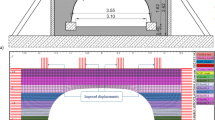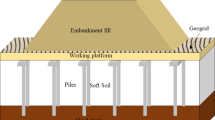Abstract
In order to research the dynamic stress–strain relationship of EPS (expanded polystyrene) particles light weight soil, under the condition of fixed water content and fixed curing age, the dynamic deformation properties of light weight soil with different mixing ratios are researched by dynamic triaxial tests. The results show that at the same cycle number and dynamic stress, the dynamic strain of light weight soil decreases with the increasing of cement content and the decreasing of EPS particles content. The dynamic bearing capacity of EPS particles light weight soil with cement content in the range of 10–20% and EPS particles content in the range of 0.14–0.86% is 1.5–3 times that of remolded soil. It indicates that light weight soil possesses obvious dynamic bearing capacity. In addition, when the vibration frequency increases from 0.5 to 6 Hz, the bigger the loading rate is, the more uneven the distribution of the pore water pressure in the soil is, and the less deformation can occur, which means that there is a greater constraint on the development of pore water pressure and deformation. Thus at the same dynamic strain, the dynamic stress of light weight soil under bigger vibration frequency is greater. The shape of dynamic backbone curves of light weight soil conforms to hyperbola, and its nonlinear dynamic response process can be described by Hardin–Drnevich model. Different stress state tests are used to verify the applicability of Hardin–Drnevich model. It is found that the relative errors between the measured values and calculated values of backbone curves are less than 15% by analysing the test data. It shows that Hardin–Drnevich model can be used to describe the dynamic deformation characteristics of EPS particles light weight soil.








Similar content being viewed by others
References
American Society for Testing and Materials. ASTM D1632-17 (2017) Standard Practice for Making and Curing Soil-Cement Compression and Flexure Test Specimens in the Laboratory. Philadelphia: ASTM, 2017
American Society for Testing and Materials. ASTM D5311-92 (1992) Standard Test Method for Load Controlled Cyclic Triaxial Strength of Soil. Philadelphia: ASTM, 1992
American Society for Testing and Materials. ASTM D698-12 (2012) Standard Test Methods for Laboratory Compaction Characteristics of Soil Using Standard Effort. Philadelphia: ASTM, 2012
Gao H, Bu C, Wang Z, Shen Y, Chen G (2017) Dynamic characteristics of expanded polystyrene composite soil under traffic loadings considering initial consolidation state. Soil Dyn Earthq Eng 102:86–98
Hardin BO, Drnevich VP (1972) Shear modulus and damping in soils: measurement and parameter effect. J Soil Mech Found Div 98(6):603–624
Hou T (2008) Experimental study on mechanical properties of foamed particle light weight soil mixed with silt. China Univ Geosci, Wuhan
Hou T (2012a) Influence of expanded polystyrene size on deformation characteristic of light weight soil. J Central South Univ 19(11):3320–3328
Hou T (2012b) Influence law of characteristic water content on basic properties of light weight soil. Rock Soil Mech 33(9):2581–2587
Hou T (2014) Model for compaction density and engineering properties of light weight soil. Chin J Geotech Eng 36(11):2127–2135
Hou T, Xu G (2009) Experiment on triaxial pore water pressure–stress–strain characteristics of foamed particle light weight soil. China J Highw Transp 22(6):10–17
Hou T, Xu G (2010) Experimental study on the shear strength characteristics of formed particle light weight soil. J China Univ Min Technol 39(4):534–540
Hou T, Xu G (2011) Influence law of EPS size on shear strength of light weight soil. Chin J Geotech Eng 33(10):1634–1641
Hu H, Duan X, He Z, Yang Yu, Liu Y (2018a) Mechanical properties and meso mechanical performance evaluation of coarse-grained soil fillers based on dynamic triaxial CT test. China J Highw Transp 31(1):42–50
Hu X, Zhang Y, Guo L, Wang J, Cai Y, Fu H, Cai Y (2018b) Cyclic behavior of saturated soft clay under stress path with bidirectional shear stresses. Soil Dyn Earthq Eng 104:319–328
Idriss IM, Seed HB (1968) Seismic response of horizontal soil layers. J Soil Mech Found Div 94(4):1003–1031
Kong L, Wang Y, Zheng Y (2001) Development in soil dynamic constitutive model. J Ningxia University (Nat Sci Ed) 22(1):17–22
Kumar SS, Krishna AM, Dey A (2017) Evaluation of dynamic properties of sandy soil at high cyclic strains. Soil Dyn Earthq Eng 99:157–167
Lei H, Li B, Lu H, Ren Q (2016) Dynamic deformation behavior and cyclic degradation of ultrasoft soil under cyclic loading. J Mater Civ Eng 28(11):1–10
Li B, Gao Y-F (2007) Experimental study on dynamic deformation characteristics of lightweight clay-EPS beads soil. Chin J Geotech Eng 29(7):1042–1047
Li B, Gao Y-F, Feng T-G (2008) Cyclic loading frequency effect and mechanism of lightweight clay-EPS beads soil. Rock Soil Mech 29(10):2731–2734
Li G, Zhang B, Yu Y (2013) Soil mechanics, 2nd edn. Tsinghua University Press, Beijing
Liu X, Yang G, Fang W (2011) Dynamic constitutive relation and dynamic modulus attenuation model of red clay. Hydrogeol Eng Geol 38(3):66–72
Luo J (2015) Determination of traffic load parameters in indoor test highway. Low Temp Archit Technol 37(3):121–123
Ma S, Wang B, Liu Y, Shao Yu, Wang H, Wang Y (2019) Large-scale dynamic triaxial tests on saturated gravel soil in Nanning metro area. Chin J Geotech Eng 41(1):168–174
Martin GR, Finn WDL, Seed HB (1978) Effects of system compliance on liquefaction tests. J Geotech Eng Div 104(4):463–480
Ministry of Water Resources of People’s Republic of China (1999) GB/T50123-1999, Standard for soil test method. Chinese Planning Press, Beijing
Onimaru S, Koseki J, Miyashita Y, Mikami T, Suzuki Y (2012) Dynamic shear strength of improved soil with b-type blast-furnace cement. Zairyo 61(1):64–67
Shen Z (1983) An equivalent viscoelastic model for calculating the liquefaction deformation of sand soil. In: Proceedings of the fourth national conference on soil mechanics and basic engineering. China Architecture & Building Press, Beijing, pp 199–207
Ueno K, Kuroda S, Hori T, Tatsuoka F (2019) Elastic shear modulus variations during undrained cyclic loading and subsequent reconsolidation of saturated sandy soil. Soil Dyn Earthq Eng 116:476–489
Wang J, Wang R (2005) The study of the soil dynamic constitutive model. Sichuan Build Sci 31(5):84–86
Wang S, Gao Y, Zhang Y (2007) Study on strength criteria and failure mechanism of lightweight sand-EPS beads soil (LSES) under dynamic loads. J Hohai Univ (Nat Sci) 35(2):197–201
Wichtmann T, Triantafyllidis T (2015) Stress attractors predicted by a high-cycle accumulation model confirmed by undrained cyclic triaxial tests. Soil Dyn Earthq Eng 69:125–137
Yasuhara K, Yamanouchi T, Hirao K (1982) Cyclic strength and deformation of normally consolidation clay. Soils Found 22(3):77–91
Funding
Project (51509211) supported by National Natural Science Foundation of China; Project (2016M602863) supported by China Postdoctoral Science Foundation; Project (2018031) supported by Excellent Science and Technology Activities Foundation for Returned Overseas Teachers of Shaanxi Province; Project (2015SF260) supported by Social Development Foundation of Shaanxi Province; Project (2017BSHYDZZ50) supported by Postdoctoral Science Foundation of Shaanxi Province; Project (2016GY-01) supported by Yangling District Foundation; Project (Z102021848, Z109021807) supported by the Fundamental Research Funds for the Central Universities; Project (A213021602) supported by International Cooperation Foundation of Northwest A&F University; Project (A213021803) supported by Foreign Cultural and Educational Experts Foundation of Northwest A&F University.
Author information
Authors and Affiliations
Corresponding authors
Additional information
Publisher's Note
Springer Nature remains neutral with regard to jurisdictional claims in published maps and institutional affiliations.
Rights and permissions
About this article
Cite this article
Hou, Ts., Pei, Zw., Luo, Ys. et al. Study on the Dynamic Constitutive Relationship of EPS Particles Light Weight Soil Based on Hardin–Drnevich Model. Geotech Geol Eng 38, 1785–1798 (2020). https://doi.org/10.1007/s10706-019-01130-6
Received:
Accepted:
Published:
Issue Date:
DOI: https://doi.org/10.1007/s10706-019-01130-6




